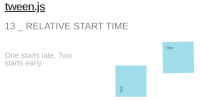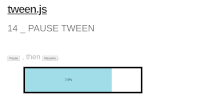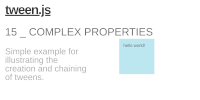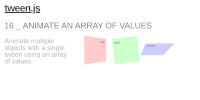JavaScript (TypeScript) tweening engine for easy animations, incorporating optimised Robert Penner's equations.
<script src="https://cdnjs.cloudflare.com/ajax/libs/tween.js/20.0.0/tween.umd.js"></script>
<div id="box"></div>
<style>
#box {
background-color: deeppink;
width: 100px;
height: 100px;
}
</style>
<script>
const box = document.getElementById('box') // Get the element we want to animate.
const coords = {x: 0, y: 0} // Start at (0, 0)
const tween = new TWEEN.Tween(coords, false) // Create a new tween that modifies 'coords'.
.to({x: 300, y: 200}, 1000) // Move to (300, 200) in 1 second.
.easing(TWEEN.Easing.Quadratic.InOut) // Use an easing function to make the animation smooth.
.onUpdate(() => {
// Called after tween.js updates 'coords'.
// Move 'box' to the position described by 'coords' with a CSS translation.
box.style.setProperty('transform', 'translate(' + coords.x + 'px, ' + coords.y + 'px)')
})
.start() // Start the tween immediately.
// Setup the animation loop.
function animate(time) {
tween.update(time)
requestAnimationFrame(animate)
}
requestAnimationFrame(animate)
</script>Install from a content-delivery network (CDN) like in the above example.
From cdnjs:
<script src="https://cdnjs.cloudflare.com/ajax/libs/tween.js/20.0.0/tween.umd.js"></script>Or from unpkg.com:
<script src="https://unpkg.com/@tweenjs/tween.js@^20.0.0/dist/tween.umd.js"></script>Note that unpkg.com supports a semver version in the URL, where the ^ in the URL tells unpkg to give you the latest version 20.x.x.
Currently npm is required to build the project.
git clone https://github.com/tweenjs/tween.js
cd tween.js
npm install
npm run buildThis will create some builds in the dist directory. There are currently two different builds of the library:
- UMD :
tween.umd.js - ES6 Module :
tween.es.js
You are now able to copy tween.umd.js into your project, then include it with a script tag, which will add TWEEN to the global scope,
<script src="path/to/tween.umd.js"></script>or import TWEEN as a JavaScript module,
<script type="module">
import * as TWEEN from 'path/to/tween.es.js'
</script>where path/to is replaced with the location where you placed the file.
You can add tween.js as an npm dependency:
npm install @tweenjs/tween.jsIf you are using Node.js, Parcel, Webpack, Rollup, Vite, or another build tool, then you can now use the following to include tween.js:
import * as TWEEN from '@tweenjs/tween.js'You can import from node_modules if you serve node_modules as part of your website, using an importmap script tag. First, assuming node_modules is at the root of your website, you can write an import map:
<script type="importmap">
{
"imports": {
"@tweenjs/tween.js": "/node_modules/@tweenjs/tween.js/dist/tween.es.js"
}
}
</script>Now in any of your module scripts you can import it by its package name:
import * as TWEEN from '@tweenjs/tween.js'- Does one thing and one thing only: tween properties
- Doesn't take care of CSS units (e.g. appending
px) - Doesn't interpolate colors
- Easing functions are reusable outside of Tween
- Can also use custom easing functions
- User guide
- Contributor guide
- Tutorial using tween.js with three.js
- Also: libtween, a port of tween.js to C by jsm174
- Understanding tween.js

|
hello world (source) |

|
Bars (source) |

|
Black and red (source) |

|
Graphs (source) |

|
Simplest possible example (source) |

|
Video and time (source) |

|
Array interpolation (source) |

|
Dynamic to, object (source) |

|
Dynamic to, interpolation array (source) |

|
Dynamic to, large interpolation array (source) |

|
Repeat (source) |

|
Relative values (source) |

|
Yoyo (source) |

|
Stop all chained tweens (source) |

|
Custom functions (source) |

|
Relative start time (source) |

|
Pause tween (source) |

|
Complex properties (source) |

|
Animate an array of values (source) |
You need to install npm first--this comes with node.js, so install that one first. Then, cd to tween.js's (or wherever you cloned the repo) directory and run:
npm installTo run the tests run:
npm testIf you want to add any feature or change existing features, you must run the tests to make sure you didn't break anything else. Any pull request (PR) needs to have updated passing tests for feature changes (or new passing tests for new features or fixes) in src/tests.ts a PR to be accepted. See contributing for more information.
Maintainers: mikebolt, sole, Joe Pea (@trusktr).













